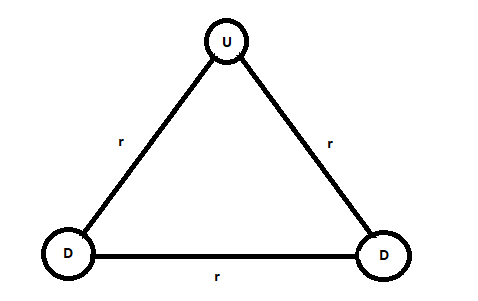Question
Question: In a quark model of elementary particles, a neutron is made of one up quark of charge \(\dfrac{2}{3}...
In a quark model of elementary particles, a neutron is made of one up quark of charge 32e and two down quarks of charges (−31e). If they have a triangle configuration with side length of order 10−15m. The electrostatic potential energy of neutron in MeV is:
Solution
The numerical problem given above can be solved easily by assuming the quarks to be the same as charged particles such as electrons. The three charged particles are arranged in a triangle arrangement.
Formula Used:
The mathematical formula for calculating electric potential energy is given as:
U = 4πε0r1[quqd+qdqd+qdqu]
In this mathematical expression, r= the distance between two quarks, qu=charge in an up quark and qd=charge in a down quark.
Complete step by step solution:
In the numerical problem given above the quarks are arranged in the form of an equilateral triangle as shown in the figure drawn below:

From the given numerical problem we know that the separation between the two charges is r=10−15m.
Also the charge of an Up quark is given as qu=32e
Similarly, the charge of a Down quark is given as qd=(−31e)
Now we can substitute these values in the mathematical expression given above. Substituting these values we get:
U = \left[ {\dfrac{1}{{4\pi {\varepsilon _ \circ }r}}} \right] \times \left\\{ {\left( {\dfrac{2}{3}e} \right)\left( {\dfrac{{ - 1}}{3}e} \right) + {{\left( {\dfrac{{ - 1}}{3}e} \right)}^2} + \left( {\dfrac{{ - 1}}{3}e} \right)\left( {\dfrac{2}{3}e} \right)} \right\\}
When we calculate the value of this mathematical equation we get:
U = \left[ {\dfrac{1}{{4\pi {\varepsilon _ \circ }r}}} \right] \times \left\\{ {\dfrac{{ - {e^2}}}{3}} \right\\}
Now we know that 4πε∘1=9×109, r=10−15and e=1.6×10−19. We can put these values in the above equation. Thus, we get:
U=10−159×109[3−(1.6×10−19)2]
Solving this we get:
U=−7.68×10−14J
But this value of electrostatic potential energy of the neutron is given in Joules but we have to calculate the value in Mega-electron Volts. Thus we have to convert the unit to MeV
We know that 1J=6.4×1012MeV. Using this to convert the equation.
Thus, U=−0.48MeV
Hence, we find that the electrostatic potential energy of the neutron in MeV is equal to −0.48MeV.
Note: It is important to be very careful while solving numerical problems of this type as the calculations tend to get very tedious and time consuming. Even if a minor mistake is made in any step it could affect the final result.
